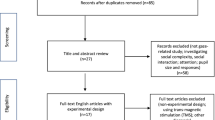Abstract
Autism spectrum disorder (ASD) is a kind of developmental disorder which attracted a lot of attention for its urgency and pervasiveness. The rapid development of machine vision technologies have brought new ideas to the auxiliary diagnosis of ASD, such as face detection, gaze estimation, action recognition, etc. The paper proposed a preliminary visual system for assistant diagnosis of ASD in a core clinical testing scenario-Response to Name (NTR). The eye center localization and gaze estimation were applied to measure the responses of the subjects. The main contribution of the article is that an experimental paradigm was established from a visual engineering perspective. The results showed that this system could analyze the response of the child for NTR accurately.
Supported by the National Natural Science Foundation of China (No. 61733011, 51575338).
Access this chapter
Tax calculation will be finalised at checkout
Purchases are for personal use only
Similar content being viewed by others
References
Rogers, S.J., Pennington, B.F.: A theoretical approach to the deficits in infantile autism. Dev. Psychopathol. 3(2), 137–162 (1991)
Xu, G., Strathearn, L., Liu, B., et al.: Prevalence of autism spectrum disorder among US children and adolescents, 2014–2016. JAMA 319(1), 81–82 (2018)
Defilippis, E.M., Jaigirdar, T., Gaglani, S.M., Sakumoto, M., Punwani, V., Desai, R., et al.: Open osmosis: library of open educational resources (OER) for medical education (2015)
Baio, J., Wiggins, L., Christensen, D.L., et al.: Prevalence of autism spectrum disorder among children aged 8 years autism and developmental disabilities monitoring network, 11 sites, United States, 2014. MMWR Surveill. Summ. 67(SS–6), 1–23 (2018). https://doi.org/10.15585/mmwr.ss6706a1
Liu, X., Wu, Q., Zhao, W., et al.: Technology-facilitated diagnosis and treatment of individuals with autism spectrum disorder: an engineering perspective. Appl. Sci. 7(10), 1051 (2017)
Charman, T.: Why is joint attention a pivotal skill in autism? Philos. Trans. R. Soc. Lond. 358(1430), 315–324 (2003)
Nadig, A.S., Ozonoff, S., Young, G.S., et al.: A prospective study of response to name in infants at risk for autism. Arch. Pediatr. Adolesc. Med. 161(4), 378 (2007)
Whitford, T.J., Rennie, C.J., Grieve, S.M., et al.: Brain maturation in adolescence: concurrent changes in neuroanatomy and neurophysiology. Hum. Brain Mapp. 28(3), 228–237 (2010)
Krupa, N., Anantharam, K., Sanker, M., et al.: Recognition of emotions in autistic children using physiological signals. Health Technol. 6(2), 137–147 (2016)
Goodwin, M.S., Intille, S.S., Velicer, W.F., et al.: Sensor-enabled detection of stereotypical motor movements in persons with autism spectrum disorder. In: International Conference on Interaction Design and Children, pp. 109–112. ACM (2008)
Han, J., Kang, J., Ouyang, G., et al.: A study of EEG and eye tracking in children with autism. Chin. Sci. Bull. 63, 1464–1473 (2018)
Guillon, Q., Hadjikhani, N., Baduel, S., et al.: Visual social attention in autism spectrum disorder: insights from eye tracking studies. Neurosci. Biobehav. Rev. 42(5), 279–297 (2014)
Bidwell, J., Essa, I.A., Rozga, A., et al.: Measuring child visual attention using markerless head tracking from color and depth sensing cameras. In: ACM International Conference on Multimodal Interaction, pp. 447–454. ACM (2014)
Chin, I., Rubin, D., Tovar, A., et al.: Dense recordings of naturalistic interactions reveal both typical and atypical speech in one child with ASD. In: International Meeting for Autism Research (2012)
Cai, H., Liu, B., Zhang, J., et al.: Visual focus of attention estimation using eye center localization. IEEE Syst. J. PP(99), 1–6 (2017)
Cai, H., Zhou, X., Yu, H., et al.: Gaze estimation driven solution for interacting children with ASD. In: International Symposium on Micro-NanoMechatronics and Human Science, pp. 1–6. IEEE (2016)
Author information
Authors and Affiliations
Corresponding authors
Editor information
Editors and Affiliations
Rights and permissions
Copyright information
© 2019 Springer Nature Singapore Pte Ltd.
About this paper
Cite this paper
Wang, Z., Liu, J., Liu, H. (2019). A Preliminary Visual System for Assistant Diagnosis of ASD: Response to Name. In: Sun, F., Liu, H., Hu, D. (eds) Cognitive Systems and Signal Processing. ICCSIP 2018. Communications in Computer and Information Science, vol 1005. Springer, Singapore. https://doi.org/10.1007/978-981-13-7983-3_7
Download citation
DOI: https://doi.org/10.1007/978-981-13-7983-3_7
Published:
Publisher Name: Springer, Singapore
Print ISBN: 978-981-13-7982-6
Online ISBN: 978-981-13-7983-3
eBook Packages: Computer ScienceComputer Science (R0)




